Some of the best music ever recorded came out of Abbey Road Studios. Now, there’s a 90-minute documentary about the nine decades of recording there.
The film is directed by someone who practically grew up at the studio, Mary McCartney. Early on, we see Mary McCartney as a baby on the floor in Abbey Road Studio Two, which is where The Beatles and her dad, Paul McCartney, often recorded. Mary McCartney was a perfect choice for this documentary because of her affection for the studio, her career as a professional photographer, and her access to the artists who recorded there. The documentary is now streaming on Disney+.
Abbey Road Studios started as EMI Recording Studios in 1931. It was the largest studio in London, and was mostly used to record classical music. The problem with classical music is that it’s not a big money maker. By the mid 1950s, the studio began recording Pop music, and by 1958 they were recording that new music style, Rock & Roll. Shortly after that, they hired producer, George Martin. He was made the youngest head of one of their labels, Parlophone Records. Let’s see, who could he find to make the label a success?
George Martin signed The Beatles in 1962, and in 1963 Beatlemania was raging in England. By 1964, artists produced by George Martin on Parlophone Records spent 36 weeks out of the year in the #1 position on the English singles chart. Other artists included Gerry & The Pacemakers and Cilla Black.
 At the premiere of the If These Walls Could Sing were Giles Martin (George’s son), Mary McCartney, Ringo Starr & his wife Barbara, Elton John, and Paul McCartney & his wife Nancy.
At the premiere of the If These Walls Could Sing were Giles Martin (George’s son), Mary McCartney, Ringo Starr & his wife Barbara, Elton John, and Paul McCartney & his wife Nancy.
Ringo Starr talked about when The Beatles recorded ten of the songs for their first album in about 12-hours. He said the long session didn’t wear them out, because “We were playing, that’s what’s important.” And in an understatement, he added “It worked out really well for us.” Ringo singled out “Yer Blues” off The White Album as his favorite recording session. He says they were in a small room, and just playing tight as a band.
Paul McCartney said they eventually had in their contract that The Beatles had limitless recording time at Abbey Road. He says, “It was our home”. He also treats us to a bit of “Lady Madonna” on the piano he originally used to record it.
Elton John was known as Reg Dwight in the late 60s. He was a studio musician at Abbey Road in 1969 when he recorded “He Ain’t Heavy, He’s My Brother” with The Hollies. If you listen closely to the recording, you can hear Elton John’s piano style shine through. Elton’s fondest memory of a session is that he was treated to a live performance of “Hey Jude”. Paul McCartney had stopped into the studio, and the band asked Paul to sing it.

Of the many other artists who commented on Abbey Road were Roger Waters & David Gilmour of Pink Floyd, and singer-songwriter Kate Bush, who all recorded there.
Pink Floyd was recording their first album at the time The Beatles were recording Sgt. Pepper’s Lonely Hearts Club Band. Roger Waters said that Sgt. Pepper is “an amazing piece of work.” “It freed a whole generation of young artists.” He said it gave them permission to write songs about real things, and gave them courage to accept their feelings.
David Gilmour talked about recording The Dark Side Of The Moon at Abbey Road Studios. He said the group clashed at times, because they all wanted the album to be as good as possible. He said they recorded the parts separately, and didn’t know what they really had until they finished and finally pushed the play button. He said, “It was absolutely magical. It was the best time I ever heard it.”
The change from EMI Studios to the name Abbey Road Studios came about in 1976, to tie in with The Beatles Abbey Road album, and because artists called it that anyway. It’s hard to believe, but during a slow time at the end of the 70s, Abbey Road was almost tuned into a car park. It was saved by Indiana Jones.
When a London studio that was used for recording movie scores closed, the large Studio One at Abbey Road was fitted with a big screen and a projector. Composer/conductor John Williams recorded the soundtrack to the film Raiders Of The Lost Ark at Abbey Road.
After that, many movies including the remaining Star Wars movies and other John Williams scores were recorded there. Director George Lucas said the recording of the scores was the most fun. He said, Abbey Road was “like a second home”. John Williams said Studio One is the perfect size to get the sound he wants. He calls Abbey Road “a gift to music”.
Mary McCartney interviewed many more musicians, so the hour-and-a-half is filled with interesting stories about Abbey Road and the music recorded there, as well as historic film and photos. If you don’t have Disney+, you might be able to use a free trial to watch this film and the 8-hour Get Back documentary.









